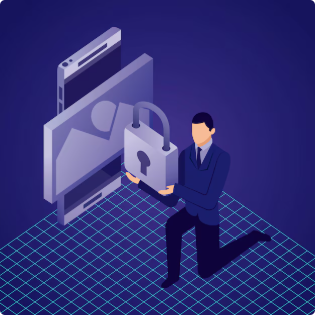Introduction
In today’s digital world, cybersecurity is very important. Organizations face ongoing security risks. Network devices and key systems are always at risk from cyberattacks. Device hardening is crucial in reducing these risks. It helps to secure systems and lower possible weak points. This helpful guide will look at different device hardening methods and the best ways to boost the security of your digital assets.
Understanding the Landscape of Digital Threats
The digital world gives us many chances, but it also presents new cyber threats. Cybercriminals always find clever ways to take advantage of system weaknesses and access private information without permission.
As more devices, networks, and applications connect, the attack surface for possible cyberattacks has grown a lot.
The Rising Complexity of Cyber Threats in India
India is changing quickly into a digital world. This growth has made it a big target for cyber threats. More people are using internet-connected devices. This has led to more data breaches and cyberattacks.
Businesses in many areas are dealing with advanced threats. These include ransomware attacks, phishing scams, and efforts to steal data. The costs of these attacks can be very high.
As India moves forward with digital technology, it is important to improve internet security. We must also strengthen the protection of devices to keep businesses and people safe.
Why Traditional Security Measures Are No Longer Enough
Traditional security measures, like firewalls and antivirus software, are important. However, they are no longer enough to handle the growing complexity of cyber threats. Attackers find new ways to get around these systems. They often exploit security vulnerabilities and target a larger attack surface.
The rise in complex IT systems and many connected devices increases security risks. This means that organizations must use a mixed-method security plan. It should go beyond old security methods to really fight off modern cyber threats.
Device hardening is a smart security method. It boosts system defenses by removing or reducing known vulnerabilities. This helps to lower the attack surface. Using this approach with traditional security methods makes the security strategy much stronger.
The Critical Role of Device Hardening
Device hardening is an important practice in cybersecurity. It means adding various security controls and settings to make network devices, servers, operating systems, applications, and databases safer. This practice helps in a strong security plan that protects important assets from unauthorized access, data breaches, and cyber threats.
When organizations harden their devices, they can improve their security greatly. This makes it harder for attackers to take advantage of weaknesses and access sensitive data. Given that cyber threats are growing in complexity and number, strong device hardening is very important for today’s security need.
Defining Device Hardening in the Context of Modern Security
System hardening means setting up security settings and policies to make a device or system more secure. It aims to lower the attack surface by getting rid of unneeded services and apps. This also includes closing unused ports, turning off default passwords, and using strong authentication methods.
The hardening process looks for possible weaknesses and checks security risks. Then, it uses the right security controls to reduce these risks. This active approach greatly lowers the chance of successful cyberattacks. It helps to protect sensitive data and keeps systems safe.
When organizations use a clear and thorough hardening process, they can build a strong security foundation. This reduces the risk of cyber incidents and improves their overall security situation.
How Device Hardening Shields Against Emerging Threats
Device hardening is a key way to protect against new cyber threats. For example, server hardening helps keep important servers and their data safe. Operating system hardening strengthens the main software that runs our computers and devices.
By fixing known problems and following security best practices, device hardening lowers the chances of successful attacks. It also helps meet regulatory compliance by making sure systems follow industry security standards.
Using device hardening shows that an organization cares about cybersecurity. This can help build trust with customers and partners. It is a vital step to protect digital assets and reduce the impact of cyberattacks.
Comprehensive Strategies for Device Hardening
Device hardening is a way to secure IT systems from different angles. Organizations must use all-around plans to keep their systems safe. This means fixing possible weaknesses in operating systems, servers, network devices, applications, and databases.
A good device hardening plan should focus on important actions first. This focuses on reducing major risks and strengthening the most valuable assets.
Prioritizing System Vulnerabilities for Immediate Action
To tackle security weaknesses and reduce risks, organizations must focus on fixing issues based on possible dangers. It is crucial to prioritize serious vulnerabilities that could cause big data leaks or system failures.
Using common industry guidelines like CIS Benchmarks can help find and fix typical vulnerabilities. These benchmarks provide a detailed set of security measures that follow industry best practices.
Here are key points to focus on:
- Update known weaknesses in operating systems, apps, and firmware.
- Set strong password rules and use multi-factor authentication.
- Turn off unnecessary services and shut unused ports.
- Regularly check and improve access controls.
Key Techniques in Operating System and Server Hardening
Server hardening and operating system hardening are important parts of a strong device protection plan. They aim to secure the main systems that run applications and store data. This helps reduce security risks.
Operating system hardening means setting security options, turning off services that are not needed, using strong password rules, and limiting user access based on need. Server hardening includes protecting the physical server, setting up firewalls, turning on intrusion detection, and securing the server’s operating system.
When organizations use these techniques, they can lower the attack surface. This helps keep their essential servers and operating systems safe from different cyber threats. It also maintains the integrity and confidentiality of sensitive data.
Enhancing Security Through Network and Software Application Hardening
To keep everything safe, it is important to protect individual devices as well as strengthen the network infrastructure and secure software applications. Network hardening means putting in place security steps to protect the network’s edge, divide networks, and secure network devices.
Software application hardening is about making applications safe from known risks. This includes protection against attacks like cross-site scripting and SQL injection.
Implementing Rigorous Network Hardening Best Practices
Network hardening is very important for keeping data safe and private as it moves through a company’s network. It includes steps to reduce security weaknesses and prevent unwanted access or attacks.
To harden a network, it is vital to set up strong firewall rules, break up networks to keep important parts safe, and use systems that detect and stop intrusions.
By focusing on security weaknesses and following best practices, companies can greatly improve the safety of their network structure. This protects sensitive information from unwanted access and cyber threats.
Strategies for Software Application Hardening
Software hardening is very important to reduce security risks tied to software problems. This process means changing security settings, setups, and structures to make applications safer.
Some key strategies include:
- Doing detailed code reviews to find and fix problems.
- Turning off features and functions that are not needed.
- Using safe coding methods.
It is also important to check and clean input to stop common web application issues, like cross-site scripting (XSS) and SQL injection.
Keeping software applications updated and patched is very important too. This helps fix new problems and decreases the chance of attacks. By using these hardening steps, organizations can greatly improve the security of their software applications and keep sensitive data safe from unauthorized access.
Adhering to System Hardening Standards and Benchmarks
Following established system hardening standards is a good way to improve security. These standards give organizations best practices, guidelines, and security setups. They help create a secure starting point for systems.
Using well-known benchmarks, like CIS Benchmarks, makes the hardening process easier. This way, systems follow best practices better.
Global versus Local Standards: Navigating Compliance in India
Navigating regulatory compliance in India often involves aligning with both global and local standards. While international benchmarks like CIS Benchmarks provide a comprehensive framework, specific regulations, such as those outlined by the Reserve Bank of India (RBI) for the banking sector, may necessitate additional security controls. Organizations operating in India must carefully assess the applicability of various standards and ensure their system hardening practices address both global best practices and local compliance requirements. The table below highlights key standards to consider:
|
Standard |
Description | Applicability | |
| CIS Benchmarks | Comprehensive security configuration guidelines | Widely applicable across industries | |
| RBI Guidelines | Specific security controls for banking and financial institutions |
Mandatory for entities regulated by the RBI |
This approach ensures a robust security posture that mitigates security risks and meets regulatory obligations.
Utilizing Checklists to Maintain System Hardening Integrity
Implementing system hardening measures is an ongoing job. It needs regular checks and updates. Using checklists that follow well-known standards like CIS Benchmarks can help. These checklists keep security settings in place and protect systems from new security vulnerabilities.
Reviewing and updating hardening checklists often helps organizations stay strong against new threats. These lists should cover all parts of system hardening. This includes things like managing user accounts, setting password rules, configuring operating systems, securing networks, and protecting applications.
By using system hardening checklists, organizations make the hardening process easier. They can lower the chances of human mistakes and keep their security controls working well. This ensures that systems stay ready for new cyber threats.
Why Choose Us for Your Device Hardening Needs?
Choosing the right cybersecurity partner is very important for making your device hardening efforts effective. Our team has a lot of experience in using the best practices in the industry. We also customize hardening solutions for businesses in India.
We know that threats are always changing and that there are specific rules to follow in the country. This allows us to offer complete and customized device hardening services. These services help improve your security and protect your important assets.
Our Unique Approach to Securing Your Digital Assets
Our way of handling cybersecurity looks beyond just fixing immediate problems. We take a complete view of your IT setup. This includes network devices, servers, applications, and data storage. Our goal is to find and reduce potential weak spots.
We start with a detailed security check to get a good idea of your organization’s security status and its risks. After that, we create a special strategy for hardening devices that fits your business goals and needs for compliance.
Our team uses well-known methods and best practices. This helps to reduce the attack surface and improve the safety of your digital assets. We also provide continuous support and monitoring to keep you protected from new threats.
Proven Success Stories from Our Clients in India
Our strong history of helping businesses in India deal with cyber threats shows our skill and dedication. We have put in place device hardening steps for companies in many areas. This has made their security much better and has lowered their chances of facing cyberattacks.
Our clients have seen a big drop in security issues. They have also met industry rules more easily. We are proud to provide real results that build trust and give our clients peace of mind.
These success stories show our commitment to great cybersecurity services. We will keep working hard to protect businesses from changing cyber threats.
Step-by-Step Guide to Device Hardening
Device hardening is not something you do just once. It is a process that continues over time. You need to plan, carry out, and keep up with it carefully. Using a clear method helps make sure all important parts are covered.
The next part gives you a simple guide on how to put device hardening steps into action for your organization.
Initial Assessment and Planning for Hardening
Before starting the system hardening process, it’s very important to carefully check the current IT setup. This check will help find any security risks, weaknesses, and places that need quick fixing.
Once the assessment is done, organizations can prioritize their hardening tasks. They can make a clear plan that shows the steps to take, how long it will take, and what resources are needed to get it done.
During the planning phase, it’s good to set security rules, decide on standard system setups, and choose the right security tools and technologies that will help with the hardening process.
Continuous Monitoring and Updating for Optimal Security
Once you put device hardening measures in place, it is important to keep watching and updating them to stay safe. Security vulnerabilities are always being found. Attackers are also always changing their methods.
Doing regular security audits, checking for vulnerabilities, and testing for weaknesses can help find and fix any issues in server hardening, network device setups, and other security measures. It is important to be aware of the latest security threats and the best practices in the industry so you can change your hardening procedures if needed.
Having a strong patch management process is key. It helps make sure that all systems, apps, and network devices get updates and security patches on time. This can reduce the chance of being attacked through known vulnerabilities.
Conclusion
In conclusion, hardening your devices is very important to protect your digital assets from changing cyber threats. By using wide-ranging plans that focus on weak spots and meet security standards, you can make your systems stronger against possible attacks. Keeping an eye on your systems and updating them regularly is vital for good security. If you want to improve your system’s strength, please contact Zealinx. We can offer a unique approach designed for your needs to help keep your business safe online.
Frequently Asked Questions
What Makes Device Hardening Essential for Businesses in India?
India deals with more cyber threats and data breaches every day. To reduce these risks, it is important to strengthen devices, especially servers. This helps to meet rules and protect businesses from serious financial and reputational harm.
How Often Should Device Hardening Measures Be Reviewed?
Monitoring security vulnerabilities is important. Organizations must regularly check and update their device protection measures. They should follow industry best practices like CIS Benchmarks. This way, they can improve their hardening process and make changes to their network devices when necessary.
Can Device Hardening Guarantee Complete Security?
Device hardening helps lower security risks. It does this by reducing the attack surface. However, it cannot ensure full cybersecurity. Still, it is a key part of a strong security plan. It works well with other security methods and greatly strengthens system hardening.
How Does Device Hardening Benefit Compliance and Auditing?
Device hardening helps meet regulatory compliance by adjusting security settings to match standards like CIS Benchmarks. It shows that you are taking steps to fix security vulnerabilities. This makes audits easier and shows that you have strong security for your network infrastructure.












